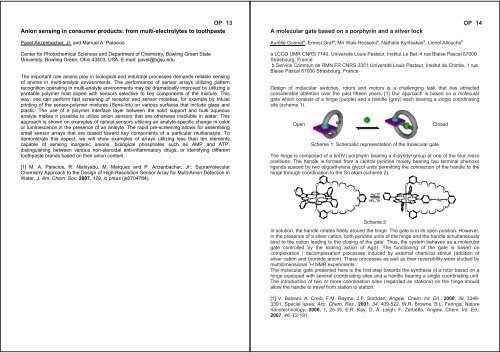ISMSC 2007 - Università degli Studi di Pavia
ISMSC 2007 - Università degli Studi di Pavia
ISMSC 2007 - Università degli Studi di Pavia
You also want an ePaper? Increase the reach of your titles
YUMPU automatically turns print PDFs into web optimized ePapers that Google loves.
OP 13<br />
Anion sensing in consumer products: from multi-electrolytes to toothpaste<br />
Pavel Anzenbacher, Jr. and Manuel A. Palacios<br />
Center for Photochemical Sciences and Department of Chemistry, Bowling Green State<br />
University, Bowling Green, Ohio 43403, USA. E-mail: pavel@bgsu.edu<br />
The important role anions play in biological and industrial processes demands reliable sensing<br />
of anions in multi-analyte environments. The performance of sensor arrays utilizing pattern<br />
recognition operating in multi-analyte environments may be dramatically improved by utilizing a<br />
printable polymer host doped with sensors selective to key components of the mixture. This<br />
way, one can perform fast screening of receptor and sensor moieties, for example by InkJet<br />
printing of the sensor-polymer mixtures (Sens-Ink) on various surfaces that include glass and<br />
plastic. The use of a polymer interface layer between the solid support and bulk aqueous<br />
analyte makes it possible to utilize anion sensors that are otherwise insoluble in water. This<br />
approach is shown on examples of optical sensors utilizing an analyte-specific change in color<br />
or luminescence in the presence of an analyte. The rapid pre-screening allows for assembling<br />
small sensor arrays that are biased toward key components of a particular multianalyte. To<br />
demonstrate this aspect, we will show examples of arrays utilizing less than ten elements<br />
capable of sensing inorganic anions, biological phosphates such as AMP and ATP,<br />
<strong>di</strong>stinguishing between various non-steroidal anti-inflammatory drugs, or identifying <strong>di</strong>fferent<br />
toothpaste brands based on their anion content.<br />
[1] M. A. Palacios, R. Nishiyabu, M. Marquez and P. Anzenbacher, Jr.: Supramolecular<br />
Chemistry Approach to the Design of High-Resolution Sensor Array for Multi-Anion Detection in<br />
Water. J. Am. Chem. Soc. <strong>2007</strong>, 129, in press (ja0704784).<br />
A molecular gate based on a porphyrin and a silver lock<br />
Aurélie Guenet a , Ernest Graf a , Mir Wais Hosseini a , Nathalie Kyritsakas a , Lionel Allouche b<br />
a LCCO UMR CNRS 7140, Université Louis Pasteur, Institut Le Bel, 4 rue Blaise Pascal 67000<br />
Strasbourg, France<br />
b Service Commun de RMN FR CNRS 2351 Université Louis Pasteur, Institut de Chimie, 1 rue<br />
Blaise Pascal 67000 Strasbourg, France<br />
Design of molecular switches, rotors and motors is a challenging task that has attracted<br />
considerable attention over the past fifteen years. [1] Our approach is based on a molecular<br />
gate which consists of a hinge (purple) and a handle (grey) each bearing a single coor<strong>di</strong>nating<br />
site (scheme 1).<br />
Open Closed<br />
Scheme 1: Schematic representation of the molecular gate<br />
The hinge is composed of a tin(IV) porphyrin bearing a 4-pyridyl group at one of the four meso<br />
positions. The handle is formed from a central pyri<strong>di</strong>ne moiety bearing two terminal phenoxo<br />
ligands spaced by two oligoethylene glycol units permitting the connection of the handle to the<br />
hinge through coor<strong>di</strong>nation to the Sn atom (scheme 2).<br />
N<br />
O<br />
N<br />
N Sn N<br />
N<br />
O<br />
O O<br />
O O<br />
O<br />
O<br />
O<br />
N Sn N<br />
AgOTf<br />
+ - NEt4 Br<br />
N<br />
N N<br />
O<br />
O<br />
O<br />
O<br />
O<br />
O O<br />
Scheme 2<br />
In solution, the handle rotates freely around the hinge. The gate is in its open position. However,<br />
in the presence of a silver cation, both pyri<strong>di</strong>ne units of the hinge and the handle simultaneously<br />
bind to the cation lea<strong>di</strong>ng to the closing of the gate. Thus, the system behaves as a molecular<br />
gate controlled by the locking action of Ag(I). The functioning of the gate is based on<br />
complexation / decomplexation processes induced by external chemical stimuli (ad<strong>di</strong>tion of<br />
silver cation and bromide anion). These processes as well as their reversibility were stu<strong>di</strong>ed by<br />
multi<strong>di</strong>mensional 1 H NMR experiments.<br />
The molecular gate presented here is the first step towards the synthesis of a rotor based on a<br />
hinge equipped with several coor<strong>di</strong>nating sites and a handle bearing a single coor<strong>di</strong>nating unit.<br />
The introduction of two or more coor<strong>di</strong>nation sites (regarded as stations) on the hinge should<br />
allow the handle to travel from station to station.<br />
[1] V. Balzani, A. Cre<strong>di</strong>, F.M. Raymo, J.F. Stoddart, Angew. Chem. Int. Ed., 2000, 39, 3348-<br />
3391, Special Issue, Acc. Chem. Res., 2001, 34, 409-522, W.R. Browne, B.L. Feringa, Nature<br />
nanotechnology, 2006, 1, 25-35, E.R. Kay, D. A. Leigh, F. Zerbetto, Angew. Chem. Int. Ed.,<br />
<strong>2007</strong>, 46, 72-191.<br />
O<br />
N<br />
O<br />
Ag<br />
O<br />
O<br />
N<br />
OP 14

















